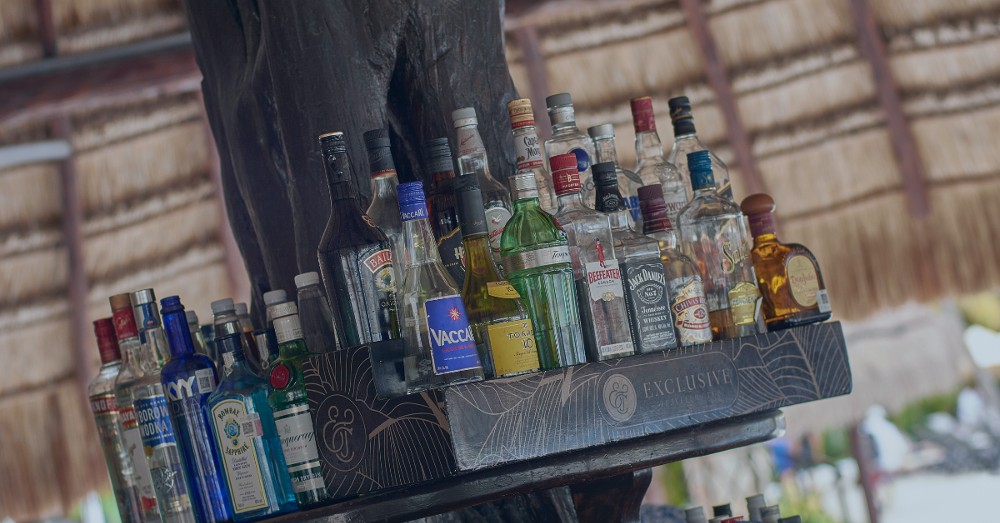As with any product in your bar or kitchen, different types of alcoholic beverages in your bar inventory have different shelf lives.
Unopened liquor with alcohol content over 40% has an almost indefinite shelf life. Liqueurs and cordials spoil faster because of their sugar content. How long they last will depend on the amount of sugar (the more there is the shorter the shelf life). Crème based liqueurs with dairy and/or eggs go off after 1.5 to 2 years unopened, while other liqueurs, like amaretto, can last for decades unopened.
Wines continue to age in the bottle, and typically have expiration dates, although some wines will get better with age. Fortified wines, on the other hand, can last one to five years unopened because of its higher alcohol content.
Once opened, alcohol spoils faster. While some beverages, like distilled liquor, will suffer less consequences than others, your bar still has to be mindful of degraded taste and colour.
The one thing all alcohol has in common is that the better stored it is, the longer it will last. So here are five tips to help improve your alcohol storage and increase shelf life.
5 tips for successfully storing alcohol in your bar
There are three major factors that affect the quality and lifespan of your alcohol: light, air and temperature. This is where we will start with our alcohol beverage storage tips.
- Don’t expose the alcohol to light
Sunlight and artificial light can break down the molecules in your liquor bottles. While this mostly impacts colour, over time, it can affect the taste as well. That’s why many bars and restaurants have interior storage for their alcoholic beverages with lighting that won’t compromise the quality of the drink. When stored at the bar, ensure the bottles are out of direct sunlight.
- Reduce the amount of air the alcohol is exposed to
When your alcohol is exposed to air (or more specifically the oxygen in the air), it can cause oxidation. Oxidation speeds up the aging process and reduces the quality of the alcohol and degrades the flavour. In liquor, this can dull the taste and even make the drink tart. In wine, it can take away all the flavour and, over a long period of time, turn the wine into vinegar.
To reduce the effects of oxidation, you want to ensure all your alcoholic beverages are closed properly once opened. You can use the original cork/cap or a stopper. The key is to make sure it is on tight, and air can’t get into the bottle while it is being stored.
Speed pourers are best saved for hard liquor that has a long shelf life and high turnover. Always remove speed pourers when the alcohol is being stored.
- Avoid extreme temperature changes
Being too hot or too cold can severely affect the quality of your alcohol. But the right temperature is dependent on the type of alcohol.
Bottles of liquor can be safely stored at room temperature. Though many experts say the ideal temperature is 13°C to 16°C. If the temperature is too hot, the alcohol can expand and evaporate, affecting flavor.
Wine, on the other hand, needs to be stored in cooler temperatures around 11°C to 14°C. If stored in warmer temperatures, the wine will age quicker and dry out the cork. In cooler temperatures, the wine's development will be stunted. As white is normally served chilled, it can handle cooler temperatures as low as 7°C.
Crème liqueurs and fortified wines should be stored in the fridge once opened. This is because fortified wines like vermouth, port and sherry have less alcohol, which means they aren’t as well preserved and Crème liqueurs contain ingredients like eggs and dairy that do better in the fridge.
Beer should be stored at cooler temperatures between 7°C and 16°C, with light beers being stored in cooler temperatures and strong beers at higher temperatures. While beer can be stored at room temperature, it can drastically reduce its shelf life.
- Keep the bottles stored the right way
When storing wine, it is recommended you store it on its side. This will help keep the cork from drying out and shrinking, which will lead to increased oxidation. This isn’t the case for liquor. Liquor should be stored upright. If it isn’t, the alcohol can deteriorate the cork and seals, increasing oxidation. Beer should also be stored upright to reduce the formation of yeast rings.
- Empty fuller bottles last
If you have multiple bottles open, always use the bottle with less alcohol in it first. Similarly, you want to avoid leaving small amounts of alcohol in the bottom of the bottle. That’s because the less liquid there is in the bottle, the more room there is for oxygen. This in turn can increase oxidation.
If you have less than 1/3 of a bottle left, consider decanting it into a smaller bottle to reduce oxidation and expand its life.
- Don’t over order
To ensure you don’t have alcohol sitting on your shelves for excessive periods of time, open or unopened, you will want to optimize your ordering. The best way to do this is by using historical data to determine just how quickly you go through each type of alcohol. Once you know that, you can create your orders accordingly. To help keep track of sales and analyze historical trends, you can use inventory control software. This will help automate the process, saving you valuable time and resources.
- Take proper inventory
To help make sure you stay on top of your inventory and expiration dates, you need to keep a proper inventory. By regularly counting inventory, noting the number of opened bottles and tracking expirations and how long bottles have been on the shelf, you can reduce spoilage.
If you see that you have inventory that is close to expiration, such as a crème liqueur, or you have alcohol that has been on the shelf for several years, you can run promos and happy hour specials to help offload it.
By taking the time to store your alcoholic beverages properly, you can increase shelf life and reduce losses. If you are unsure whether a product has gone off, compare it to a fresh bottle. Any changes in colour or smell are signs that the alcohol may not be good anymore.
Interested in learning more about how proper inventory control can help your bar reduce product spoilage and improve profit margins? Contact the Sculpture Hospitality team today.






.png)




.png?width=520&height=294&name=Sculpture%20Blog%20Banner%20Images%20%5B2025%5D%20(2).png)
